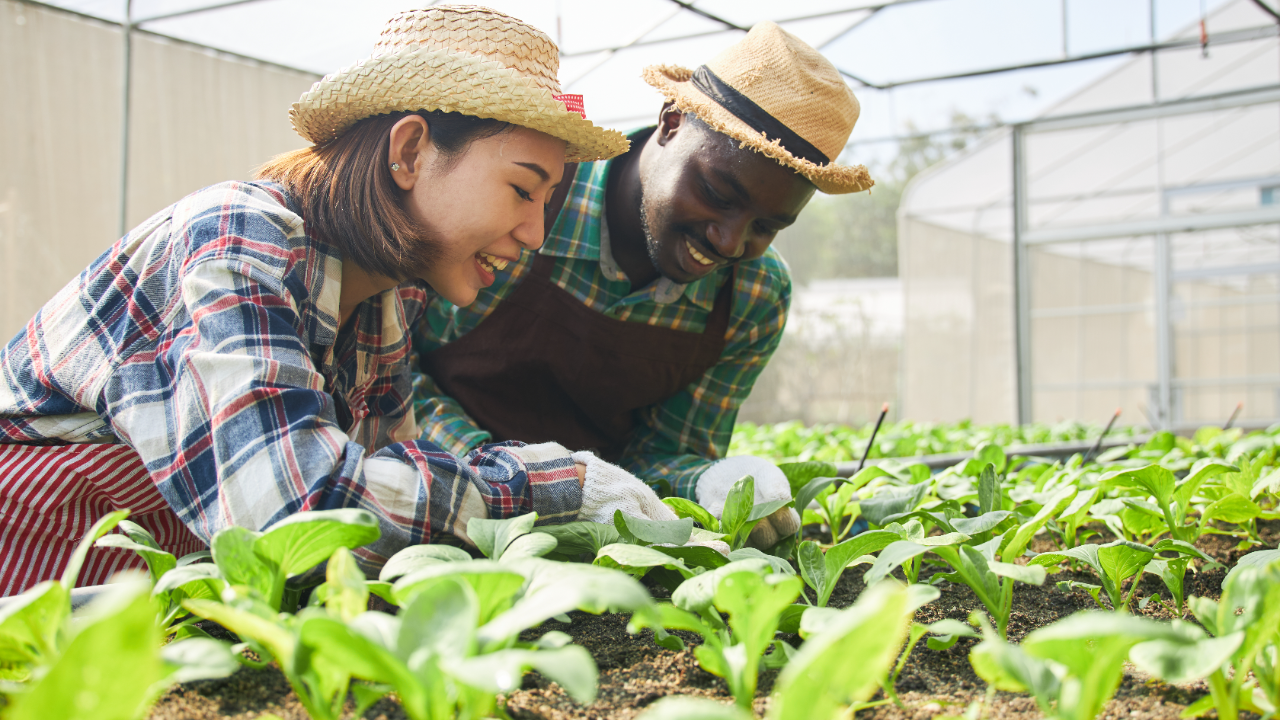11 grants for farmers

The Bankrate promise
At Bankrate we strive to help you make smarter financial decisions. While we adhere to strict , this post may contain references to products from our partners. Here's an explanation for .
Technology continues to revolutionize the way we work. Farming is no exception. That new technology requires an investment, though.
Paired with the harsh weather conditions we’ve seen in recent years, many farms are spending more than they have on hand. Farm debt — particularly non-real estate farm debt, such as money used for operating expenses or the purchase of new equipment — is rising.
Farm grants offer an alternative. These grants give farm owners money that they never need to repay. If that sounds appealing, keep reading to learn which options are available and how to get a farm grant.
Farm grants from the federal government
The U.S. Department of Agriculture (USDA) backs a wide range of farm grants. To qualify for most of them, you’ll need to meet specific criteria, like growing a certain crop or allocating the money toward a particular project. Still, whether you’re looking for a grant to start a farm or hunting for a way to boost cash flow at your established agricultural operation, federal grants are a great place to start.
1. SARE grants
Sustainable Agriculture Research and Education (SARE) is a federal grant program that offers funding for researching and learning about sustainable agriculture. The National Institute for Food and Agriculture funds SARE grants, offering multiple grants designed for specific projects like testing a new agricultural method.
The purpose of these farm grants is to further sustainable farming practices. The grant can’t be used to start or fund a farm’s operating expenses. But, businesses can use it on a limited basis to buy items for the project. Projects have to be carried out in the US or its island protectorates.
-
Applications are being accepted for SARE grants, but exact timelines vary by the grant type and your region or state. Get started by visiting your region’s SARE funding pages online. These resources can guide you in the types of grants offered in each region and what you need to apply. Most SARE grants are closed right now, but they should reopen in the spring or later in 2024.<br /><br />
-
SARE North Central: Open to residents of Illinois, Indiana, Iowa, Kansas, Michigan, Minnesota, Missouri, Nebraska, North Dakota, Ohio, South Dakota and Wisconsin and includes grant programs like:
- Research and Education Grant Program
- Farmer Rancher Grant Program
- Partnership Grant Program (for projects between farmers/ranchers and agriculture professionals)
-
SARE Northeast: Open to residents of Connecticut, Delaware, Maine, Maryland, Massachusetts, New Hampshire, New Jersey, New York, Pennsylvania, Rhode Island, Vermont, Washington, D.C. and West Virginia and includes grant programs like:
- Farmer Grant Program (for farmers testing a new idea)
- Research and Education Grant Program
- Research for Novel Approaches in Sustainable Agriculture Grant Program
- Partnership Grant Program (for projects between farmers/ranchers and agriculture professionals)
-
SARE South: Open to residents of Alabama, Arkansas, Florida, Georgia, Kentucky, Louisiana, Mississippi, North Carolina, Oklahoma, South Carolina, Tennessee, Texas and Virginia and includes grant programs like:
- On-Farm Research Grants (for on-farm projects between farmers/ranchers and agriculture professionals)
- Research and Education Grants
- Producer Grants (for farmers/ranchers testing a new idea)
-
SARE West: Open to residents of Alaska, Arizona, California, Colorado, Hawaii, Idaho, Montana, Nevada, New Mexico, Utah, Washington and Wyoming and includes grant programs like:
- Farmer/Rancher (for advancing on-farm sustainability)
- Professional + Producer (for projects between farmers/ranchers and agriculture professionals)
-
SARE North Central: Open to residents of Illinois, Indiana, Iowa, Kansas, Michigan, Minnesota, Missouri, Nebraska, North Dakota, Ohio, South Dakota and Wisconsin and includes grant programs like:
2. Specialty Crop Block Grant Program
The Specialty Crop Block Grant aims to motivate farming businesses to grow specialty crops. By receiving funding, farmers can keep these vital crops accessible while boosting competition among specialty crop growers.
For these farm grants, the USDA defines specialty crops as:
- Fruits (including dried fruit)
- Tree nuts
- Vegetables
- Horticulture
- Plants grown in a nursery (including floriculture)
-
This grant has closed its doors to incoming applications. You can check its website in February 2024 to see if the program is accepting new applications. When the funding window is open again, follow these steps to apply:<br /><br />
- Go to the federal government grants website.
- Create an account with Grants.gov if you’re a new applicant.
- Search for the Specialty Crop Multi-State Program grant and apply.
3. Beginning Farmer and Rancher Development Program
The Beginning Farmer and Rancher Development Program is designed to support farmers within the first 10 years of their farming journey. So, this is a great option if you’re looking to start a farm.
The program can fund projects that educate and train beginner farmers to succeed and build long-lasting businesses. To be eligible for this grant, the farm needs to be part of a nonprofit or for-profit collaborative group, like a farmers’ co-op.
-
Applications are currently closed. The application for 2024 should be released in February or March. The deadline for submitting an application is usually about 60 days after the new application comes out, so be ready to submit by April or May. The USDA states its exact deadline in the Request for Applications.To apply for the Beginning Farmer and Rancher Development Program, follow these steps:<br /><br />
- See if you’re eligible by reading through the requirements on page 16 of the 2023 Request for Applications guide.
- Create an account on the federal government’s grants website.
- Then, when the time comes, find the beginner farmer development grant and apply.
4. Renewable Energy Systems & Energy Efficiency Improvement Grant
The Renewable Energy Systems & Energy Efficiency Improvement Grant is a federal program that guarantees loans and offers grants to agricultural and rural small businesses. The program offers funding for businesses that are diving into renewable energy projects.
Businesses need to operate in an approved rural area or at least gain 50 percent of revenue from agriculture. You also need to meet the SBA’s criteria for a small business, and you have to use loan funds within the US.
-
To apply for the Rural Energy for America Program grant or loan, you need to:<br /><br />
- Navigate to the Rural Energy for America Program (REAP) homepage.
- Select your state from the dropdown menu.
- Reach out to your state’s energy coordinator to determine if your farm or business qualifies. Otherwise, you can speak with a state office representative.
- Complete the application according to your representative’s instructions.
5. Farmers Market Promotion Program
The Farmers Market Promotion Program aims to support farmers who sell products directly to the customer, specifically with marketing. Your business may sell through farmers’ markets, a farm cooperative, as a pick-your-own produce farm or another form of direct-to-consumer selling. The goal of the program is to boost local farm production by broadening local farmers’ reach.
The program requires farmers to match the amount funded by the USDA by 25 percent. You can use either business or personal revenue or cash from fundraisers or investors. The USDA also counts products and services given to your business for free or at a discount.
The program offers multiple tracks to help you choose and get approved for a project. It includes a Turnkey Marketing and Promotion track, which lets you choose from a list of USDA-approved project goals.
-
Applications for this grant are currently closed as of May 2, 2023. Until the USDA posts another upcoming deadline, you would need to qualify for a late application.<br /><br />Late applications are only accepted for businesses with one of these qualifying events: a natural disaster or catastrophe or a technical difficulty. A technical difficulty can include waiting for other government officials to respond to your requests.
6. Patrick Leahy Farm to School Grant Program
Not only does this grant aim to connect kids to farmers, but it can also be used by farms or groups of farms if your farm provides any food to schools (or you could use the grant to do so). In 2023, for example, Wild Pansy Farm in Indiana received nearly $15,000 to canvass 18 counties to explore bringing soup with their farmed ingredients to schools. If you want to see what’s worked in your state, you can see the full list of 2023 recipients here.
-
The grant is currently open. Like many of the other federal grants we’ve outlined, if you want to figure out how to get a farm grant under the Patrick Leahy program, you start at the federal grants website. This grant program’s page provides eligibility information, so make sure you qualify. Click the red “Apply” button when you’re ready to get started.
7. Value-Added Producer Grant program
The Value-Added Producer Grant program aims to support farmers with business goals that boost production or expand the farming operation, aiming to add value to the farming industry.
Farmers can use the funds to research, write business plans or market their new product. Specifically, funds are applied toward planning or working capital expenses. If you’re in a disadvantaged community, you may receive priority for getting funding approved.
Large farms may need proof that financing their idea will allow farming to expand into a new market. The USDA will review and approve your project, ensuring that your business goals align with the USDA’s purpose to grow the farming community.
-
The application window is currently closed for new applications as of May 16, 2023. You can check when applications will be accepted on the program’s website.
Private-sector farm grants
While the federal government offers several farm grants, they’re not your only option for grant money. Here are a few grants from other sources that might be a better fit for your farm.
8. Farm Bureau Ag Innovation Challenge
The Farm Bureau Ag Innovation Challenge is a private grant awarded to people or businesses that develop innovative solutions and improvements to farming. The grant is offered by the American Farm Bureau Federation and Farm Credit, a lender specializing in farm loans.
Farming businesses chosen will compete against each other to showcase their innovative ideas to industry experts and investors. Ten businesses will receive grants ranging from $5,000 to $50,000. The overall winner and runner-up will be featured on the Farm Bureau website. But the event can introduce all businesses competing to mentorship, funding and recognition.
-
To be eligible, you need to be a member of your local Farm Bureau. You can contact the Farm Bureau directly by phone at 202-406-3600 or email info@fb.org for more information.
9. Fund-a-Farmer Grants
The Food Animal Concerns Trust (FACT) backs these Fund-a-Farmer grants with awards of up to $3,000 to expand pasture or improve farm animals’ welfare.
To be eligible, you need to raise one of the following:
- Beef cattle
- Bison
- Broiler chickens
- Dairy cows
- Ducks
- Geese
- Goats
- Laying hens
- Pigs
- Sheep
- Turkeys
-
You can apply on the Fund-a-Farmer webpage.Before you dig into the application, you may want to review the PDFs linked on that page. They provide valuable information like example applications and previously funded projects.Applications for this round are due by January 15, 2024.
10. Sky High Farm grants
Since 2022, Sky High Farm has formed a diverse grant committee each year to issue a handful of microgrants. This grant program is geared toward underserved communities, such as Black, Indigenous, Latinx, Asian, migrant, refugee and other groups, that are often excluded from traditional funding opportunities. Farmers who receive the grants demonstrate how the work on their farm aligns with an overarching mission.
-
Sky High Farms is not currently accepting grant applications for 2023. The last round of funding closed on April 15, 2023. The grant program has run annually for the last two years, so keep an eye on the farm’s website for 2024 funding.
11. Young Farmer Grant program
The National Young Farmers Coalition and Chipotle team up for this grant, which awards $5,000 each to young farmers every spring. In 2020–2022, 50 farmers received the grant, and in 2023, the program expanded to 75 farmers. The majority of those recipients already had established farms, but eight were just founding their operation, so this is worth considering if you’re just starting out.
-
To be eligible for this grant, you need to be under the age of 40. The 2023 funding round is closed, but the National Young Farmers Coalition promises to release information about 2024’s Young Farmer grants shortly. Keep an eye on the website for those details to drop.
Farm grants from state agencies
If you’re exploring how to get a farm grant from federal or private entities and coming up empty-handed, you have one more avenue to look into. Several states offer farm grants specifically to their residents, including the following:
-
The California Department of Food and Agriculture (CFDA) offers quite a few grant programs, including:<br /><br />
- Alternative Manure Management Program: Offers funding to help farmers put alternative methods for managing the manure from their livestock into practice.
- Dairy Digester Research and Development Program: Funds research for using livestock manure as a renewable energy source.
- Healthy Soils Program: Includes several grant programs to implement agricultural practices to reduce carbon and improve soil health.
- State Water Efficiency and Enhancement Program (SWEEP): Issues grant monies to install irrigation systems that save water and reduce greenhouse gasses.
- California Underserved and Small Producers Program (CUSP): Offers grants to small and mid-sized ranchers and farmers who are socially disadvantaged.
- Resilient Food Systems Infrastructure Program (RFSI): Provides grant money to bolster middle-of-the-supply-chain infrastructure like processing or distribution.
- Healthy Refrigeration Grant Program: Issues grants to help pay for energy-efficient refrigerators in small businesses that want to stock California-grown produce.
-
The Indiana State Department of Agriculture offers a handful of grants for its resident farmer, including:<br /><br />
- Clean Water Indiana (CWI): Funds grants for projects to implement water conservation practices and reduce water pollution.
- Specialty Crop Block Grant (SCBG): Issues grant money to support the growing of specialty crops, applying the USDA definition of specialty crops (fruits, vegetables, tree nuts, dried fruits, horticulture and nursery crops, including floriculture).
- Resilient Food Systems Infrastructure Program (RFSI): Offers grant money to support aggregation, distribution, market expansion, facility updates and expansions and storage capacity projects that will help stabilize the middle of the food chain.
-
The Minnesota Department of Agriculture has several grants, so we’ll highlight just a few here.<br /><br />
- AGRI Beginning Farmer Farm Business Management Scholarships: Funds scholarships for people looking for a grant to start a farm who want to get good management techniques under their belt by attending classes at a Minnesota State college or university.
- AGRI Good Agricultural Practices/Good Handling Practices Certification Cost-Share: Covers up to 75 percent of an individual’s Good Agricultural Practices (GAP) and Good Handling Practices (GHP) certification costs.
- AGRI Livestock Investment Grant: Issues grant money to help ranchers and livestock farmers improve, update or modernize their livestock operation infrastructure, including equipment.
-
The Missouri Department of Agriculture backs a few grant programs, all of which are currently closed but may reopen at a future date:<br /><br />
- Missouri Value-Added Agriculture Grant Program: Offers grant funding to help build or expand a value-adding agriculture business concept, including expenses for business plans, feasibility studies, marketing plans and more.
- Missouri Value-Added Agriculture “Farm to Table” Grant: Funds equipment like coolers, bagging equipment and more for small businesses purchasing locally grown agriculture products from small farmers.
- Show-Me Entrepreneurial Grants for Agriculture: Provides funding for farmers to add value to agricultural products in categories like innovation and technical assistance (requiring a 25 percent match from the grant recipient).
-
The Texas Department of Agriculture extends more than 20 grants to Lone Star State residents, including:<br /><br />
- Young Farmer Grant (YFG): Offers dollar-for-dollar grant fund matching twice-yearly to applicants under age 46 who want to create or expand an agricultural business in Texas.
- Interest Rate Reduction (IRR): Lowers interest rates by placing a deposit with the lending institution linked to the approved loan; includes the Young Farmer Interest Rate Reduction (YFIRR) for further interest rate reduction.
- Community Development Block Grant (TxCDBG) Program for Rural Texas: Funds grants to help develop economic opportunities (along with housing) in non-entitlement (i.e., not HUD-supported) cities with a population of less than 50,000.
Bottom line
Figuring out how to get a farm grant isn’t easy. The application process is usually involved, and you’ll likely pour some hours into it. Still, though, the payout can be huge: from a few thousand dollars up to six figures, depending on the grant program. And since farm grants give you money you don’t need to pay back, they can be a huge advantage to your agricultural operation. Look at federal, state and private farm grants to determine which suits your farm best.
Frequently asked questions
-
In addition to the grant opportunities we’ve laid out, you could explore a farm loan, seeking out investors or bootstrapping it with your own funds.
-
No. But your state and federal government may help you through farm grants for everything from irrigation systems to training in management best practices.
-
Per the USDA, socially disadvantaged farmers and ranchers (SDFRs) are people who have historically faced racial or ethnic discrimination, including Black, American Indian, Alaska Native, Hispanic, Latino, Asian and Pacific Islander farmers and ranchers. In some USDA programs, women also fall under the SDFR umbrella.
Related Articles



